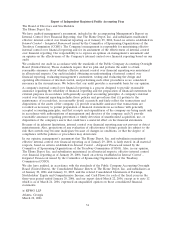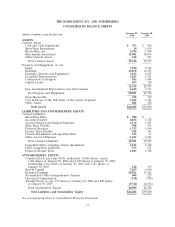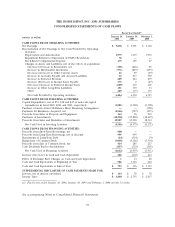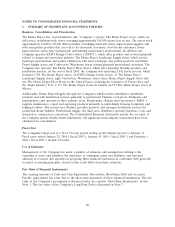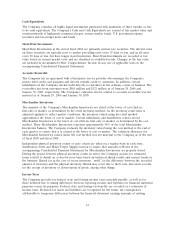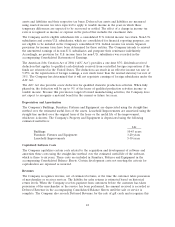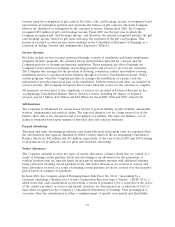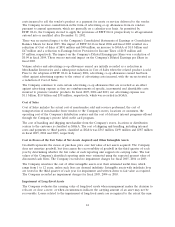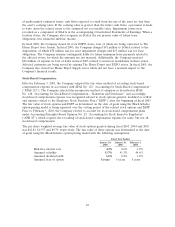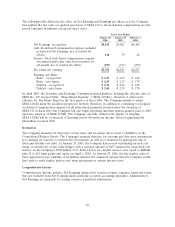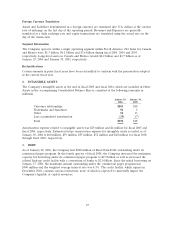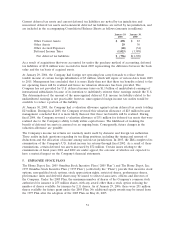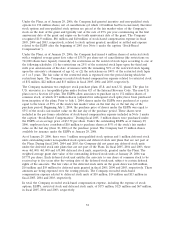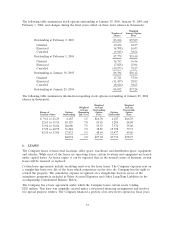Home Depot 2005 Annual Report Download - page 55
Download and view the complete annual report
Please find page 55 of the 2005 Home Depot annual report below. You can navigate through the pages in the report by either clicking on the pages listed below, or by using the keyword search tool below to find specific information within the annual report.revenue upon the redemption of gift cards in Net Sales. Gift card breakage income is recognized based
upon historical redemption patterns and represents the balance of gift cards for which the Company
believes the likelihood of redemption by the customer is remote. During fiscal 2005, the Company
recognized $52 million of gift card breakage income. Fiscal 2005 was the first year in which the
Company recognized gift card breakage income, and therefore, the amount recognized includes the gift
card breakage income related to gift cards sold since the inception of the gift card program. This
income is recorded as other income and is included in the Consolidated Statement of Earnings as a
reduction in Selling, General and Administrative Expenses (‘‘SG&A’’).
Services Revenue
Net Sales include services revenue generated through a variety of installation and home maintenance
programs. In these programs, the customer selects and purchases material for a project and the
Company provides or arranges professional installation. These programs are offered through the
Company’s stores and focus primarily on providing products and services to do-it-for-me customers.
The Company also arranges for the provision of flooring, countertop, cabinet and window covering
installation services to production home builders through its Creative Touch Interiors brand. Under
certain programs, when the Company provides or arranges the installation of a project and the
subcontractor provides material as part of the installation, both the material and labor are included in
services revenue. The Company recognizes this revenue when the service for the customer is complete.
All payments received prior to the completion of services are recorded in Deferred Revenue in the
accompanying Consolidated Balance Sheets. Services revenue, including the impact of deferred
revenue, was $4.3 billion, $3.6 billion and $2.8 billion for fiscal 2005, 2004 and 2003, respectively.
Self-Insurance
The Company is self-insured for certain losses related to general liability, product liability, automobile,
workers’ compensation and medical claims. The expected ultimate cost for claims incurred as of the
balance sheet date is not discounted and is recognized as a liability. The expected ultimate cost of
claims is estimated based upon analysis of historical data and actuarial estimates.
Prepaid Advertising
Television and radio advertising production costs along with media placement costs are expensed when
the advertisement first appears. Included in Other Current Assets in the accompanying Consolidated
Balance Sheets are $42 million and $33 million, respectively, at the end of fiscal 2005 and 2004 relating
to prepayments of production costs for print and broadcast advertising.
Vendor Allowances
The Company currently receives two types of vendor allowances: volume rebates that are earned as a
result of attaining certain purchase levels and advertising co-op allowances for the promotion of
vendors’ products that are typically based on guaranteed minimum amounts with additional amounts
being earned for attaining certain purchase levels. All vendor allowances are accrued as earned, and
those allowances received as a result of attaining certain purchase levels are accrued over the incentive
period based on estimates of purchases.
In fiscal 2003, the Company adopted Emerging Issues Task Force No. 02-16, ‘‘Accounting by a
Customer (Including a Reseller) for Certain Consideration Received from a Vendor’’ (‘‘EITF 02-16’’),
which states that cash consideration received from a vendor is presumed to be a reduction of the prices
of the vendor’s products or services and should, therefore, be characterized as a reduction of Cost of
Sales when recognized in the Company’s Consolidated Statements of Earnings. That presumption is
overcome when the consideration is either a reimbursement of specific, incremental and identifiable
43



